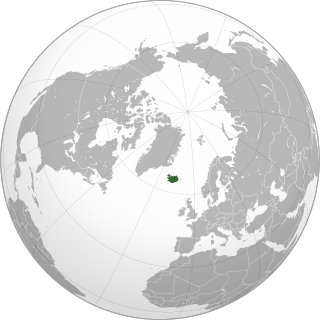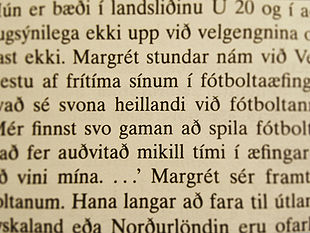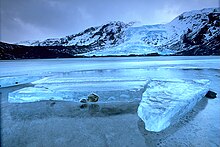User:WanderingMorpheme/Icelandic language
| Icelandic | |
|---|---|
| íslenska | |
| Pronunciation | [ˈist.l̥ɛn.ska] |
| Native to | Iceland |
| Ethnicity | Icelanders |
Native speakers | 357,069 (2018) |
Early forms | |
| Latin (Icelandic alphabet) Icelandic Braille | |
| Official status | |
Official language in | |
| Regulated by | Árni Magnússon Institute for Icelandic Studies[a] |
| Language codes | |
| ISO 639-1 | is |
| ISO 639-2 | ice (B) isl (T) |
| ISO 639-3 | isl |
| Glottolog | icel1247 |
| Linguasphere | 52-AAA-aa |
 Iceland, where Icelandic is the majority language | |
Icelandic (/aɪsˈlændɪk/ ⓘ; Icelandic: íslenska pronounced [ˈis.tl̥ɛn.ska] ⓘ) is a North Germanic language spoken by about 314,000 people, the vast majority of whom live in Iceland, where it is the national language.[1] Since it is a West Scandinavian language, it is most closely related to Faroese, western Norwegian dialects, and the extinct language Norn. It is not mutually intelligible with the continental Scandinavian languages (Danish, Norwegian, and Swedish) and is more distinct from the most widely spoken Germanic languages, English and German. The written forms of Icelandic and Faroese are very similar, but their spoken forms are not mutually intelligible.[2]
The language is more conservative than most other Germanic languages. While most of them have greatly reduced levels of inflection (particularly noun declension), Icelandic retains a four-case synthetic grammar (comparable to German, though considerably more conservative and synthetic) and is distinguished by a wide assortment of irregular declensions. Icelandic vocabulary is also deeply conservative, with the country's language regulator maintaining an active policy of coining terms based on older Icelandic words rather than directly taking in loanwords from other languages.
Aside from the 300,000 Icelandic speakers in Iceland, Icelandic is spoken by about 8,000 people in Denmark,[3] 5,000 people in the United States,[4] and more than 1,400 people in Canada,[5] notably in the region known as New Iceland in Manitoba which was settled by Icelanders beginning in the 1880s.
The state-funded Árni Magnússon Institute for Icelandic Studies serves as a centre for preserving the medieval Icelandic manuscripts and studying the language and its literature. The Icelandic Language Council, comprising representatives of universities, the arts, journalists, teachers, and the Ministry of Culture, Science and Education, advises the authorities on language policy. Since 1995, on 16 November each year, the birthday of 19th-century poet Jónas Hallgrímsson is celebrated as Icelandic Language Day.[6]
Classification[edit]
Icelandic is an Indo-European language and belongs to the North Germanic group of the Germanic languages. Icelandic is further classified as a West Scandinavian language.[7] Icelandic is derived from an earlier language Old Norse, which later became Old Icelandic and currently Modern Icelandic. The division between old and modern Icelandic is said to be before and after 1540.[8]
History[edit]

Geographical distribution[edit]
Official status[edit]
According to an act passed by the Parliament in 2011, Icelandic is "the national language of the Icelandic people and the official language in Iceland"; moreover, "[p]ublic authorities shall ensure that its use is possible in all areas of Icelandic society".[9]
Iceland is a member of the Nordic Council, a forum for co-operation between the Nordic countries, but the council uses only Danish, Norwegian, and Swedish as its working languages (although the council does publish material in Icelandic).[10] Under the Nordic Language Convention, since 1987 Icelandic citizens have had the right to use Icelandic when interacting with official bodies in other Nordic countries, without becoming liable for any interpretation or translation costs. The convention covers visits to hospitals, job centres, the police, and social security offices.[11][12] It does not have much effect since it is not very well known and because those Icelanders not proficient in the other Scandinavian languages often have a sufficient grasp of English to communicate with institutions in that language (although there is evidence that the general English skills of Icelanders have been somewhat overestimated).[13]
Variation[edit]
Phonology[edit]
Consonants[edit]
All Icelandic stops are voiceless and are such distinguished by aspiration.[14] When at the beginning of the word stops are realised post-aspirated, but pre-aspirated when occurring within a word.[15][b]
| Labial | Coronal | Palatal | Velar | Glottal | ||||||
|---|---|---|---|---|---|---|---|---|---|---|
| Nasal | (m̥) | m | (n̥) | n | (ɲ̊) | (ɲ) | (ŋ̊) | (ŋ) | ||
| Stop | pʰ | p | tʰ | t | (cʰ) | (c) | kʰ | k | ||
| Continuant | sibilant | s | ||||||||
| non-sibilant | f | v | θ | ð | (ç) | j | (x) | (ɣ) | h | |
| Lateral | (l̥) | l | ||||||||
| vibrant | (r̥) | r | ||||||||
- /n̥ n tʰ t/ are laminal denti-alveolar, /s/ is apical alveolar,[16] /θ ð/ are alveolar non-sibilant fricatives; the former is laminal, while the latter is usually apical.[17]
- A phonetic analysis reveals that the voiceless lateral approximant [l̥] is, in practice, usually realised with considerable friction, especially word-finally or syllable-finally, i. e., essentially as a voiceless alveolar lateral fricative [ɬ].[18]
Scholten (2000, p. 22) includes three extra phones: [ʔ l̥ˠ lˠ].
Word-final voiced consonants are devoiced pre-pausally, so that dag ('day (acc.)') is pronounced as [ˈtaːx] and dagur ('day (nom.)') is pronounced [ˈtaːɣʏr̥].[19]
Vowels[edit]

Icelandic has 8 monopththongs and 5 diphthongs.[20] The diphthongs are created by taking a monophthong and adding either /i/ or /u/ to it.[21] All the vowels can either be long or short and is based on a length rule, vowels in open syllables are long, and vowels in closed syllables are short.[22]
| Front | Back | ||
|---|---|---|---|
| plain | round | ||
| Close | i | u | |
| Near-close | ɪ | ʏ | |
| Open-mid | ɛ | œ | ɔ |
| Open | a | ||
| Front offglide |
Back offglide | |
|---|---|---|
| Mid | ei • œi [œy][c] | ou |
| Open | ai | au |
Grammar[edit]

Vocabulary[edit]


Early Icelandic vocabulary was largely Old Norse with a few words being Celtic from when Celts first settled in Iceland.[24][25] The introduction of Christianity to Iceland in the 11th century brought with it a need to describe new religious concepts. The majority of new words were taken from other Scandinavian languages; kirkja ("church"), for example. Numerous other languages have influenced Icelandic: French brought many words related to the court and knightship; words in the semantic field of trade and commerce have been borrowed from Low German because of trade connections. In the late 18th century, language purism began to gain noticeable ground in Iceland and since the early 19th century it has been the linguistic policy of the country (see linguistic purism in Icelandic).[26] Nowadays, it is common practice to coin new compound words from Icelandic derivatives.
Icelandic personal names are patronymic (and sometimes matronymic) in that they reflect the immediate father or mother of the child and not the historic family lineage. This system, which was formerly used throughout the Nordic area and beyond, differs from most Western systems of family name. In most Icelandic families, the ancient tradition of patronymics is still in use; i.e. a person uses their father's name (usually) or mother's name (increasingly in recent years) in the genitive form followed by the morpheme -son ("son") or -dóttir ("daughter") in lieu of family names.[27]
In 2019, changes were announced to the laws governing names. Icelanders who are officially registered with non-binary gender will be permitted to use the suffix -bur ("child of") instead of -son or -dóttir.[28]
Linguistic purism[edit]
Starting in the late 16th century discussion has been ongoing on the purity of the Icelandic language, the bishop Oddur Einarsson wrote in 1589 that the language has remained unspoilt since the time the ancient literature of Iceland was written.[29] Later in the 18th century the purism movement got bigger and more works were translated into Icelandic, especially in areas where Icelandic had hardly ever been used in, with this came many neologisms, with many of them being loan-translations, with the ultimate goal of cleansing the language of foreign words.[29][30] In the early 19th century people were influenced by romanticism and a bigger importance was put on the purity of spoken language, instead of just the written language. The written language was also brought closer to the spoken language as the sentence structure of literature had previously been influenced by Danish and German.[31]
The changes brought by the purism movement have had the most influence on the written language, as many speakers use foreign words freely in speech, but try to avoid them when writing. The success of the many neologisms created from the movement has also been variable as some loanwords have not been replaced with native ones.[32] There is still a conscious effort to create new words, especially for science and technology, with many societies publishing dictionaries, some with the help of The Icelandic Language Committee (Íslensk málnefnd).[33]
Language policy[edit]
A core theme of Icelandic language ideologies is grammatical, orthographic and lexical purism for Icelandic. This is evident in general language discourses, in polls, and in other investigations into Icelandic language attitudes.[34] The general consensus on Icelandic language policy has come to mean that language policy and language ideology discourse are not predominantly state or elite driven; but rather, remain the concern of lay people and the general public.[35] The Icelandic speech community is perceived to have a protectionist language culture,[27] however, this is deep-rooted ideologically primarily in relation to the forms of the language, while Icelanders in general seem to be more pragmatic as to domains of language use.[36]
English influence[edit]
Writing system[edit]
The modern Icelandic alphabet consists of 32 letters in the Latin script: a, á, b, d, ð, e, é, f, g, h, i, í, j, k, l, m, n, o, ó, p, r, s, t, u, ú, v, x, y, ý, þ, æ, ö (which also have the capital forms: A, Á, B, D, Ð, E, É, F, G, H, I, Í, J, K, L, M, N, O, Ó, P, R, S, T, U, Ú, V, X, Y, Ý, Þ, Æ, Ö).[37] It also has four additional letters found in foreign words: c, q, w, z (capitals being: C, Q, W, Z).[38] The letters with diacritics, such as á and ö are separate letters and not variants of other letters.[39]
History[edit]
The letter é officially replaced je in 1929, although it had been used in early manuscripts (until the 14th century) and again periodically from the 18th century.[40] The letter z was formerly in the Icelandic alphabet, but it was officially removed in 1974, except in people's names.[41][42][43]
See also[edit]
- Basque–Icelandic pidgin (a pidgin that was used to trade with Basque whalers)
- Icelandic exonyms
- Icelandic literature
- Icelandic name
References[edit]
Notes[edit]
Citations[edit]
- ^ WanderingMorpheme/Icelandic language at Ethnologue (19th ed., 2016)

- ^ Barbour & Carmichael 2000, p. 106.
- ^ "StatBank Denmark". www.statbank.dk.
- ^ "Icelandic". MLA Language Map Data Center. Modern Language Association. Archived from the original on 6 December 2010. Retrieved 17 April 2010. Based on 2000 US census data.
- ^ Government of Canada, Statistics Canada (8 May 2013). "2011 National Household Survey: Data tables". www12.statcan.gc.ca.
- ^ "Icelandic: At Once Ancient And Modern" (PDF). Icelandic Ministry of Education, Science and Culture. 2001. Archived from the original (PDF) on 26 August 2019. Retrieved 27 April 2007.
- ^ Karlsson 2013, p. 8.
- ^ Thráinsson 1994, p. 142.
- ^ "Act [No 61/2011] on the status of the Icelandic language and Icelandic sign language" (PDF). Ministry of Education, Science and Culture. p. 1. Retrieved 15 November 2013.
Article 1; National language – official language; Icelandic is the national language of the Icelandic people and the official language in Iceland. Article 2; The Icelandic language — The national language is the common language of the Icelandic general public. Public authorities shall ensure that its use is possible in all areas of Icelandic society. All persons residing in Iceland must be given the opportunity to learn Icelandic and to use it for their general participation in Icelandic society, as further provided in leges speciales.
- ^ "Norden". Retrieved 27 April 2007.
- ^ "Nordic Language Convention". Archived from the original on 29 June 2007. Retrieved 27 April 2007.
- ^ "Nordic Language Convention". Archived from the original on 28 April 2009. Retrieved 27 April 2007.
- ^ Robert Berman. "The English Cognitive Academic Language Proficiency of Icelandic students, and how to improve it". Archived from the original on 4 March 2016.
English is often described as being almost a second language in Iceland, as opposed to a foreign language like German or Chinese. Certainly in terms of Icelandic students' Basic Interpersonal Communication Skills (BICS), English does indeed seem to be a second language. However, in terms of many Icelandic students' Cognitive Academic Language Proficiency (CALP)—the language skills required for success in school—evidence will be presented suggesting that there may be a large number of students who have substantial trouble utilizing these skills.
- ^ Árnason 2011, p. 99.
- ^ a b Flego & Berkson 2020, p. 1.
- ^ Kress 1982, pp. 23-24: "It's never voiced, as s in sausen, and it's pronounced by pressing the tip of the tongue against the alveolar ridge, close to the upper teeth – somewhat below the place of articulation of the German sch. The difference is that German sch is labialized, while Icelandic s is not. It's a pre-alveolar, coronal, voiceless spirant.".
- ^ Ladefoged & Maddieson 1996, pp. 144–145.
- ^ Liberman, Mark. "A little Icelandic phonetics". Language Log. University of Pennsylvania. Retrieved 1 April 2012.
- ^ Árnason 2011, pp. 107, 237.
- ^ Flego & Berkson 2020, p. 8.
- ^ Árnason 2011, p. 57.
- ^ Árnason 2011, pp. 58–59.
- ^ Árnason 2011, p. 58.
- ^ Brown & Ogilvie 2010, p. 781.
- ^ Karlsson 2013, p. 9.
- ^ Van der Hulst 2008.
- ^ a b Hilmarsson-Dunn & Kristinsson 2010.
- ^ Kyzer, Larissa (22 June 2019). "Icelandic names will no longer be gendered". Iceland Review.
- ^ a b Karlsson 2013, p. 36.
- ^ Ragnarsson 1992, pp. 121–122.
- ^ Karlsson 2013, pp. 37–38.
- ^ Karlsson 2013, p. 38.
- ^ Thráinsson 1994, p. 188.
- ^ Kristinsson 2018.
- ^ Kristinsson 2013.
- ^ Kristinsson 2014.
- ^ Neijmann 2022, pp. 3–4.
- ^ Neijmann 2022, p. 4.
- ^ Neijmann 2022, p. 5.
- ^ Kvaran, Guðrún (12 November 2001). "Hvenær var bókstafurinn 'é' tekinn upp í íslensku í stað 'je' og af hverju er 'je' enn notað í ýmsum orðum?". Vísindavefurinn (in Icelandic). Retrieved 20 June 2007.
- ^ Kvaran, Guðrún (7 March 2000). "Hvers vegna var bókstafurinn z svona mikið notaður á Íslandi en því svo hætt?". Vísindavefurinn (in Icelandic). Archived from the original on 29 October 2023. Retrieved 29 October 2023.
- ^ Ragnarsson 1992, p. 148.
- ^ Neijmann 2022, p. 25.
Bibliography[edit]
- Árnason, Kristján; Sigrún Helgadóttir (1991). "Terminology and Icelandic Language Policy". Behovet och nyttan av terminologiskt arbete på 90-talet. Nordterm 5. Nordterm-symposium. pp. 7–21.
- Árnason, Kristján (2011), The Phonology of Icelandic and Faroese, Oxford University Press, ISBN 978-0-19-922931-4
- Barbour, Stephen; Carmichael, Cathie (2000). Language and Nationalism in Europe. OUP Oxford. ISBN 978-0-19-158407-7.
- Brown, Edward Keith; Ogilvie, Sarah (2010). Concise encyclopedia of languages of the world. Elsevier. ISBN 9780080877754. OCLC 944400471.
- Halldórsson, Halldór (1979). "Icelandic Purism and its History". Word. 30: 76–86.
- Hilmarsson-Dunn, Amanda; Kristinsson, Ari Páll (2010). "The language situation in Iceland". Current Issues in Language Planning. 11 (3): 207–276. doi:10.1080/14664208.2010.538008. ISSN 1466-4208. S2CID 144856348.
- Karlsson, Stefán (2013) [2004]. The Icelandic language. Translated by McTurk, Rory (Reprinted with minor corrections ed.). London: Viking Society for Northern Research, University College London. ISBN 978-0-903521-61-1.
- Kress, Bruno (1982), Isländische Grammatik, VEB Verlag Enzyklopädie Leipzig
- Kristinsson, Ari Páll (1 November 2013). "Evolving language ideologies and media practices in Iceland / Die Entwicklung neuer Sprachideologien und Medienpraktiken in Island / Evolution des ideologies linguistiques et des pratiques médiatiques en Islande". Sociolinguistica (in German). 27 (1): 54–68. doi:10.1515/soci.2013.27.1.54. ISSN 1865-939X. S2CID 142164040.
- Kristinsson, Ari Páll (24 October 2014). "Ideologies in Iceland: The protection of language forms". In Hultgren, Anna Kristina; Gregersen, Frans; Thøgersen, Jacob (eds.). English in Nordic Universities. Studies in World Language Problems. Vol. 5. John Benjamins Publishing Company. pp. 165–177. doi:10.1075/wlp.5.08kri. ISBN 978-90-272-2836-9.
- Kristinsson, Ari Páll (2018). "National language policy and planning in Iceland – aims and institutional activities" (PDF). Hungarian Academy of Sciences, Research Institute for Linguistics. Budapest: 243–249. ISBN 978-963-9074-74-3.
- Kvaran, Guðrún; Höskuldur Þráinsson; Kristján Árnason; et al. (2005). Íslensk tunga I–III. Reykjavík: Almenna bókafélagið. ISBN 9979-2-1900-9. OCLC 71365446.
- Ladefoged, Peter; Maddieson, Ian (1996). The Sounds of the World's Languages. Oxford: Blackwell. ISBN 0-631-19815-6.
- Neijmann, Daisy L. (2022). Icelandic: An Essential Grammar (1st ed.). Routledge. doi:10.4324/9781315731056. ISBN 978-1-315-73105-6.
- Orešnik, Janez; Magnús Pétursson (1977). "Quantity in Modern Icelandic". Arkiv för Nordisk Filologi. 92: 155–71.
- Ragnarsson, Baldur (1992). Mál og málsaga [Language and language history] (in Icelandic). Mál og Menning. ISBN 978-9979-3-0417-3.
- Rögnvaldsson, Eiríkur (1993). Íslensk hljóðkerfisfræði [Icelandic phonology]. Reykjavík: Málvísindastofnun Háskóla Íslands. ISBN 9979-853-14-X.
- Scholten, Daniel (2000). Einführung in die isländische Grammatik. Munich: Philyra Verlag. ISBN 3-935267-00-2. OCLC 76178278.
- Flego, Stefon; Berkson, Kelly (8 July 2020). "A Phonetic Illustration of the Sound System of Icelandic". ResearchGate.
- Thráinsson, Höskuldur (1994). "Icelandic". In König, Ekkehard; Van der Auwera, Johan (eds.). The Germanic languages. Routledge language family descriptions. London: Routledge. ISBN 978-0-415-05768-4.
- Van der Hulst, Harry (2008). Word Prosodic Systems in the Languages of Europe. Mouton de Gruyter. p. 377. ISBN 978-1282193666. OCLC 741344348.
- Vikør, Lars S. (1993). The Nordic Languages. Their Status and Interrelations. Oslo: Novus Press. pp. 55–59, 168–169, 209–214.
External links[edit]
- The Árni Magnússon Institute for Icelandic Studies
- Íðorðabankinn, dictionary for technical words.
- Collection of Icelandic bilingual dictionaries
